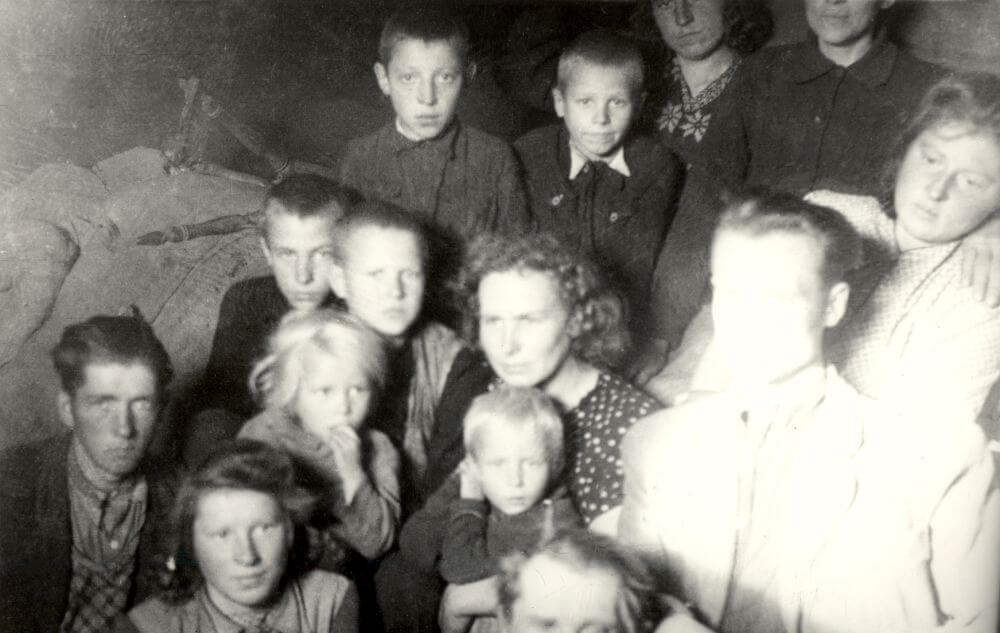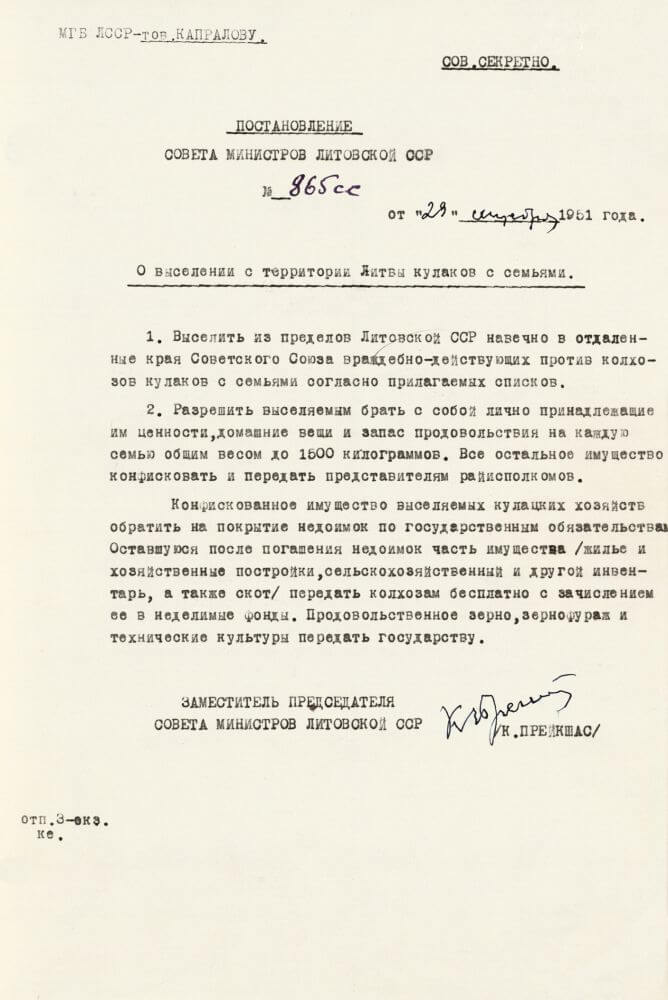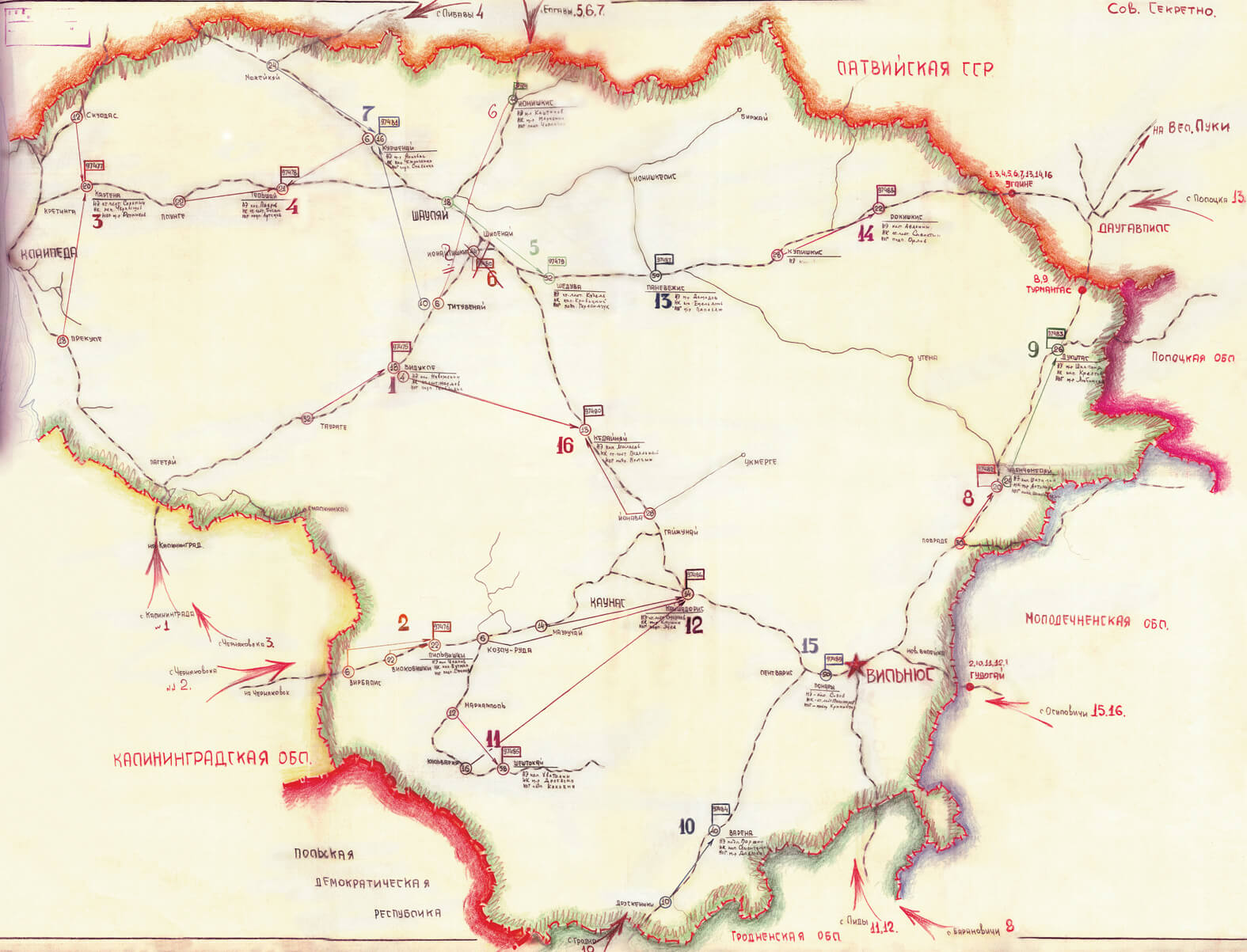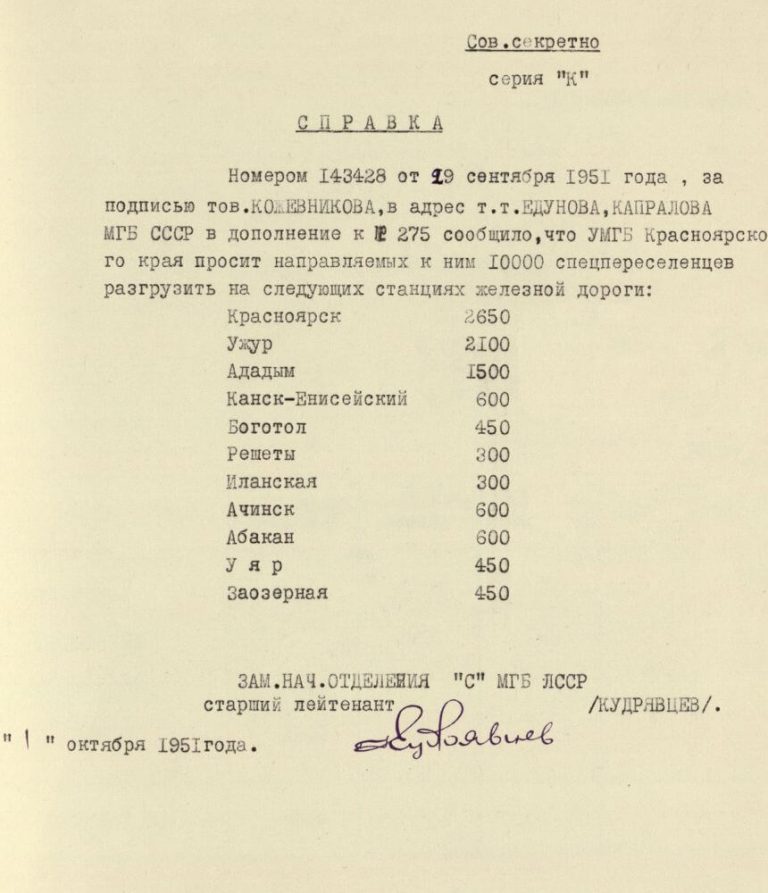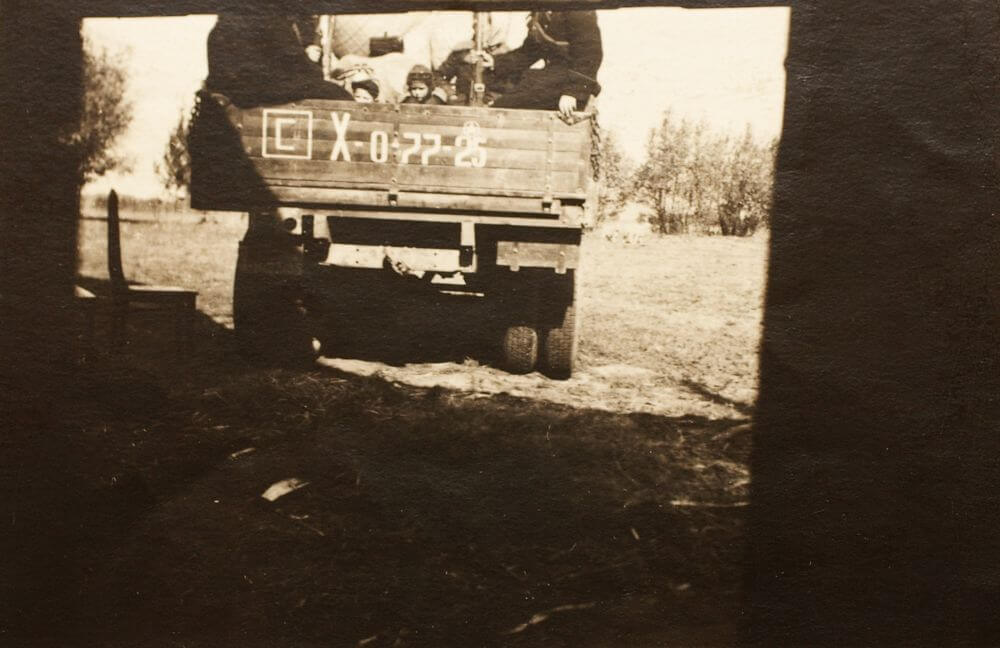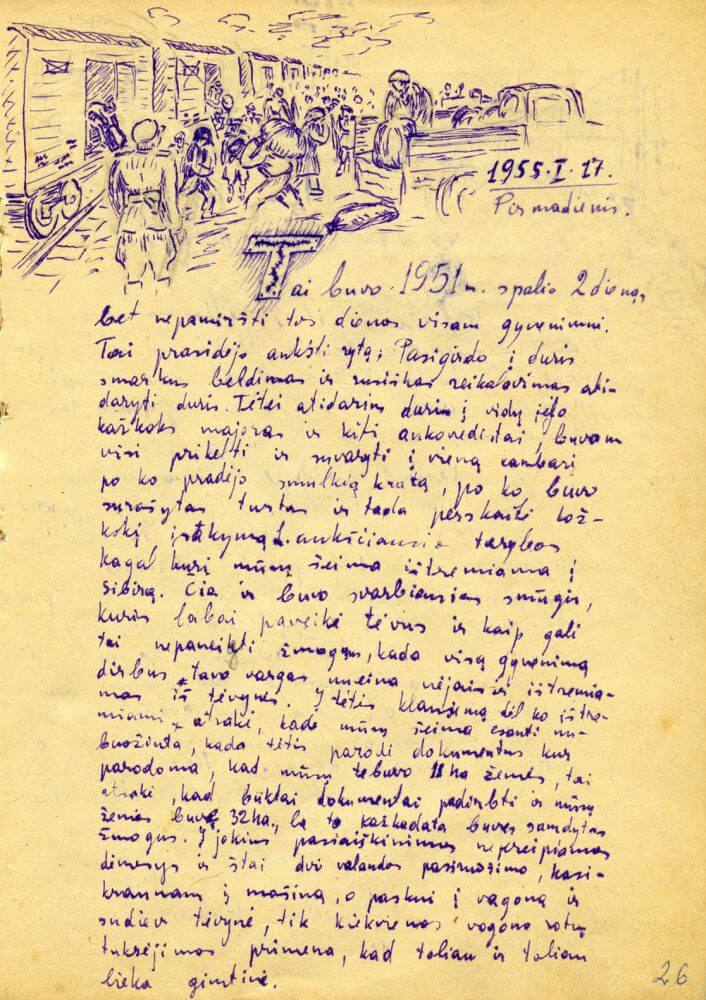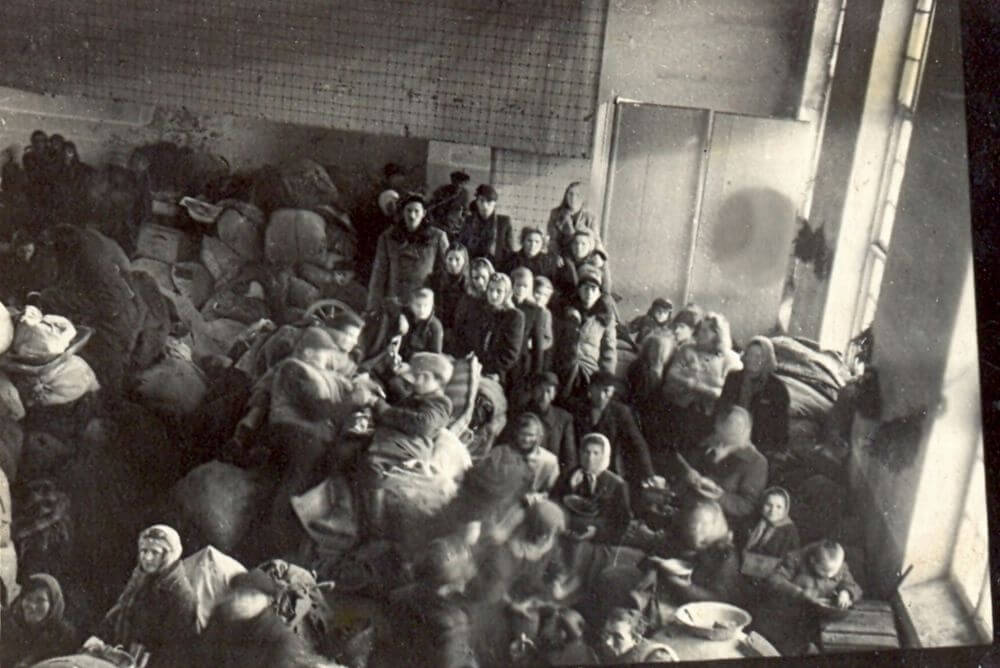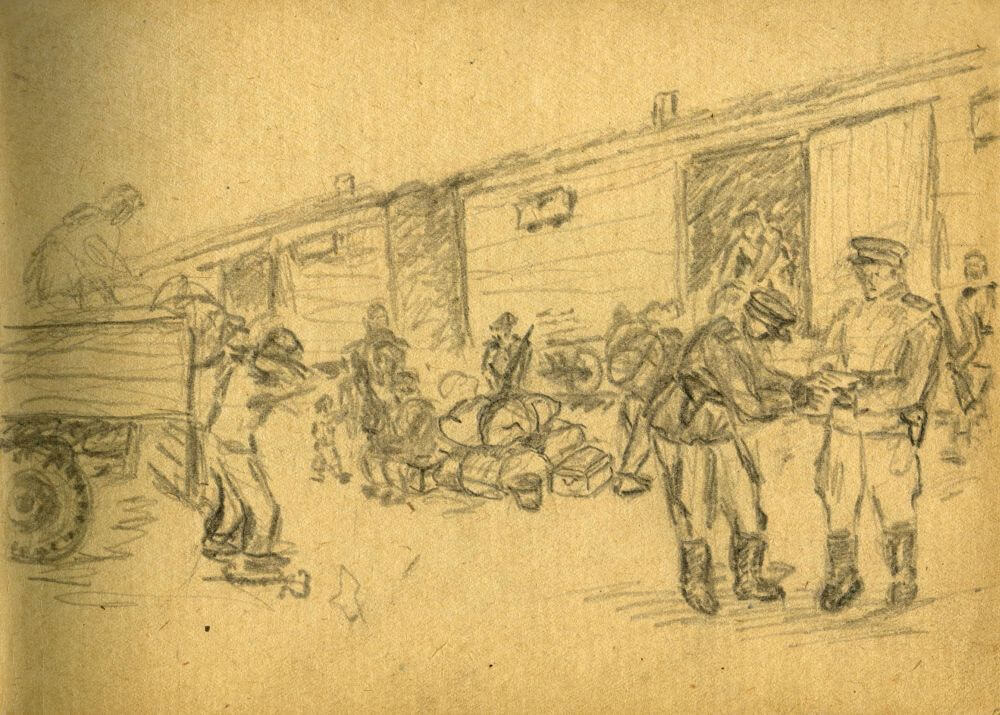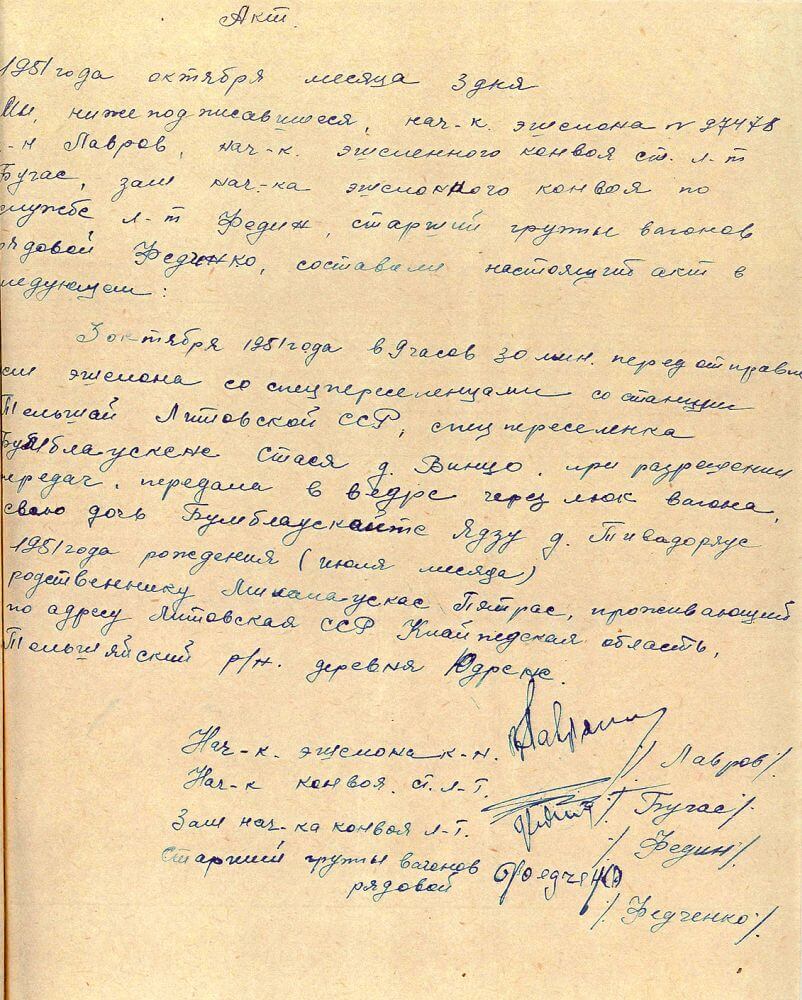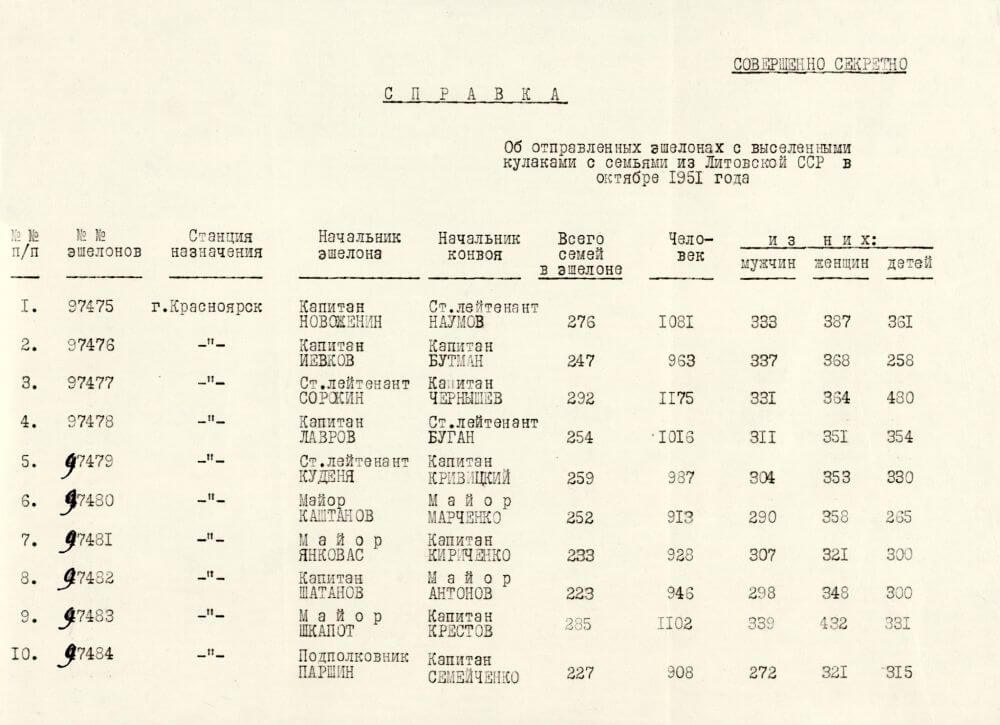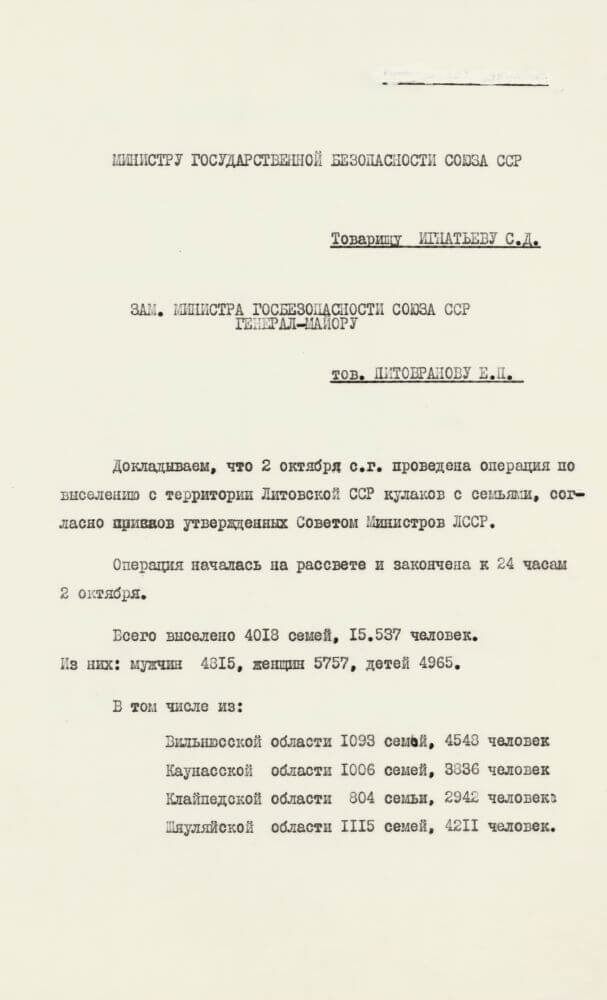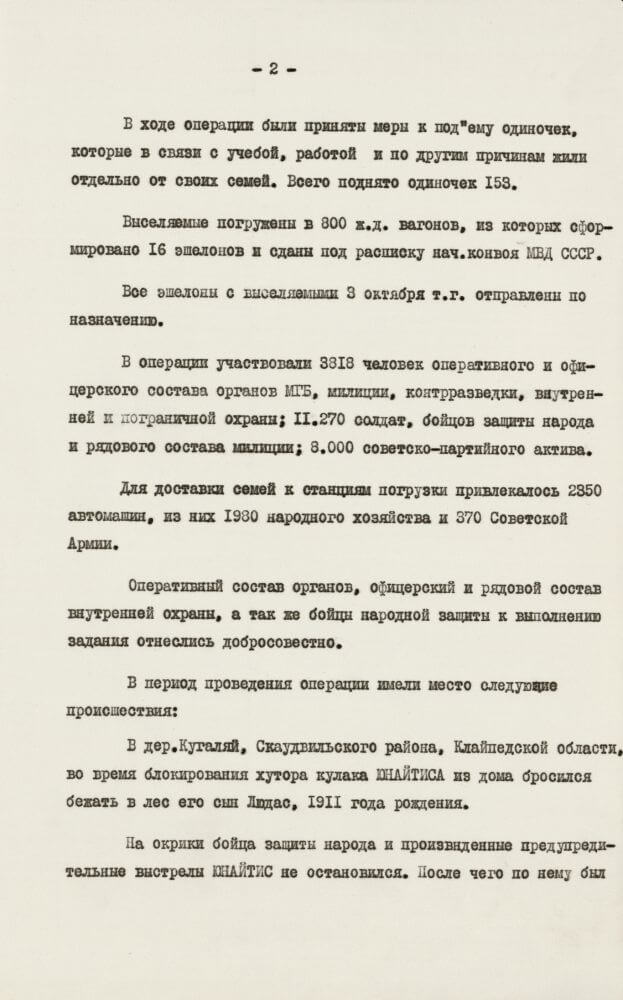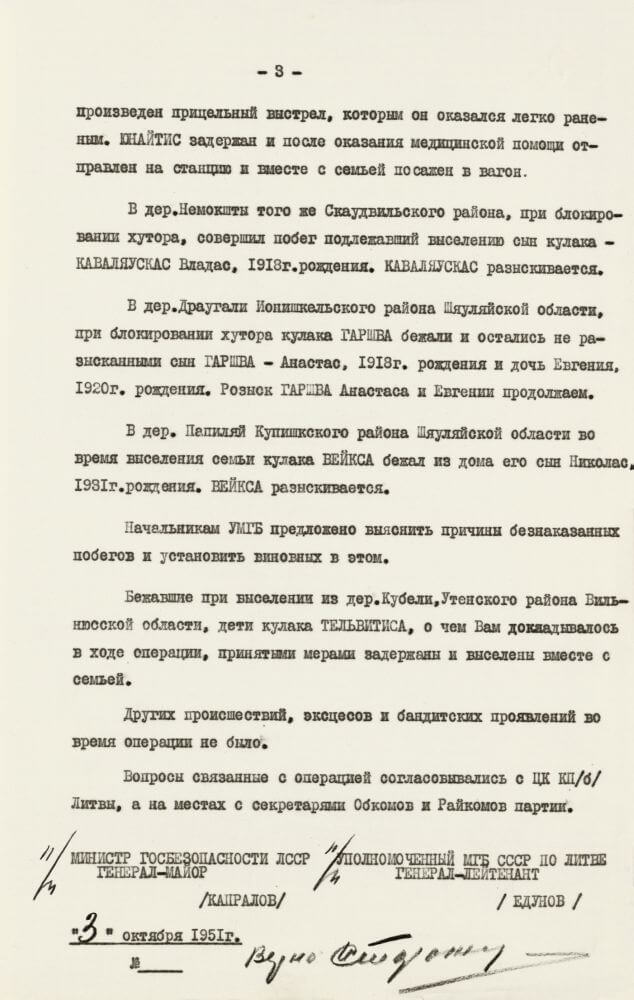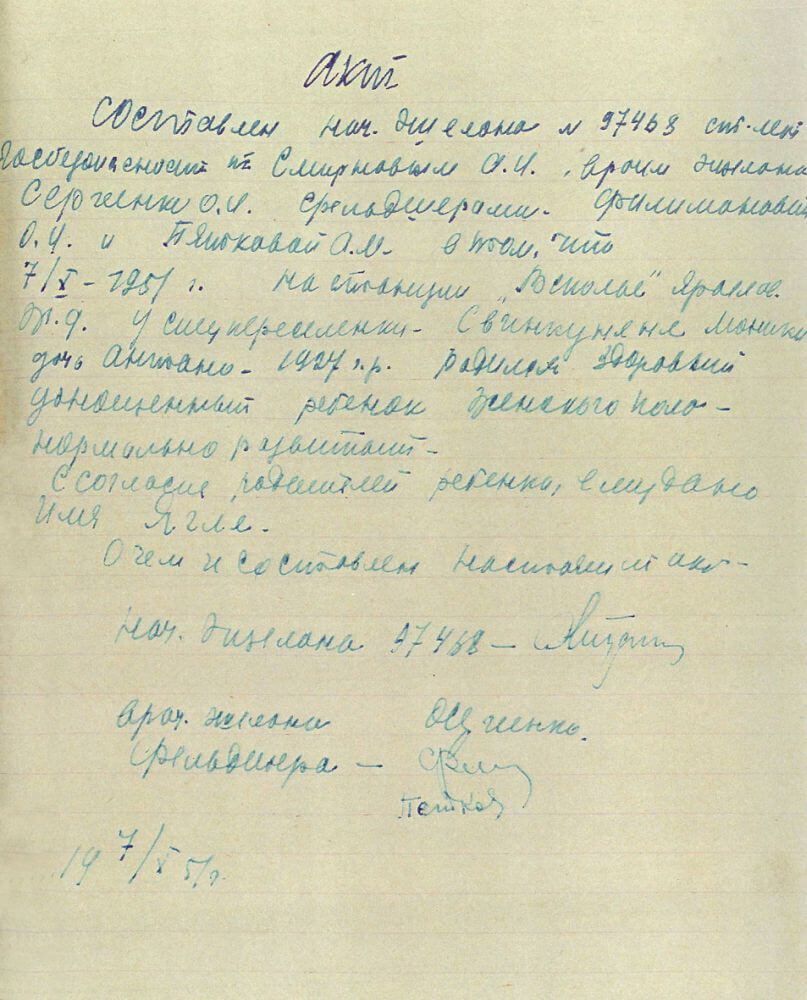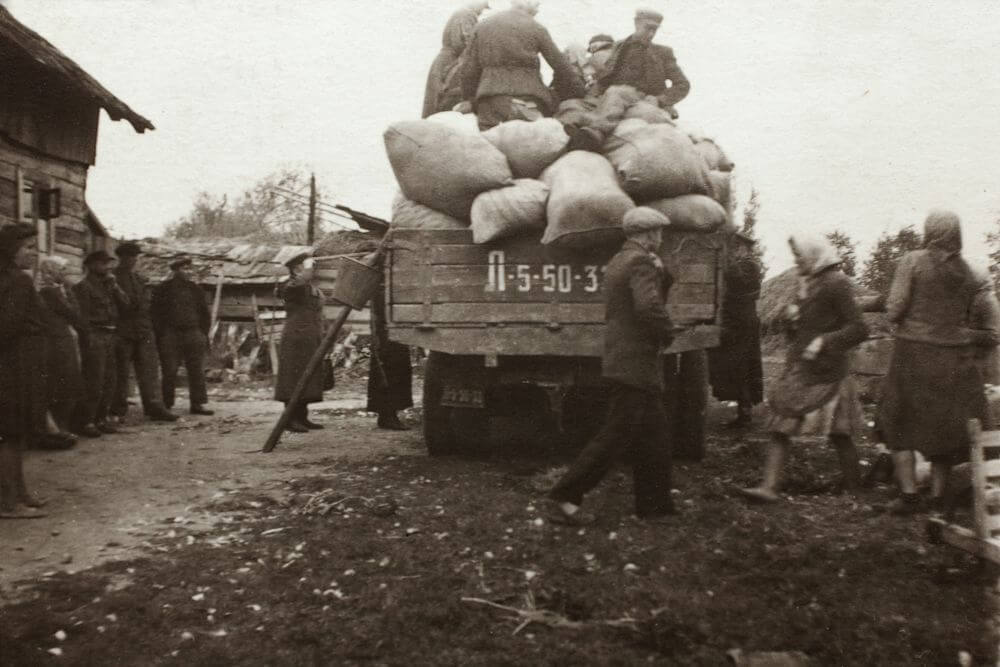
1951 DEPORTATION – OPERATION OSENJ
On 2 October 1951, the mass deportation of the Lithuanian population began under the codename Osenj (‘Autumn’). This operation was preceded and followed by smaller-scale deportations in September and November. The aim of all these deportations was to bring the forced collectivisation to an end as quickly as possible and to weaken the ranks of the supporters of the fighting partisans.
The deportations were sanctioned by the USSR Council of Ministers, which on 5 September 1951 adopted decree “On the deportation of kulaks and their families from the territory of the Lithuanian SSR”. The decree was signed by Chairman of the USSR Council of Ministers Joseph Stalin and Administrator of the Affairs of the Council of Ministers, Mikhail Pomaznev. The resolution announced that the Soviet government had decided to “permanently transfer 4,000 anti-kolkhoz kulaks and their families to Krasnoyarsk Krai and Tomsk Oblast”. On the following day, a meeting of the leadership of the LSSR’s Ministry of State Security (MGB) took place, attended by the USSR MGB commissioners Nikolai Miakotnykh and Yakov Yedunov, the LSSR Minister of State Security Piotr Kapralov and his deputies Andrey Leonov and Leonardas Martavičius, head of the 2-N Board Ilya Pochkai, heads of the LSSR MGB regional boards and interrogation units, and other high-ranking MGB officials. The participants were given a briefing by Yakov Yedunov.
It is not known what instructions were given at this meeting, but the Chekists were preparing for the deportation operation rapidly: they ‘identified’ 4,215 ‘kulak farms’, with 14,950 people living in them. By 28 September 1951 the MGB’s regional administrations had drawn up the main and reserve lists of deportees. The main lists included 4,007 farm owners and their families, and the reserve lists included 998. The people on the main list were to be deported first, but after falling short of the ‘target’, the reserve list was used as well. The lists of deportees were approved by the LSSR Council of Ministers.
In autumn 1951, the deportations were organised in several stages. The first deportation took place on 20-21 September. Then 822 families (3,072 people in total) were deported to Irkutsk Oblast. All of them were relatives of the partisans or families of partisan supporters and messengers.
The largest-scale deportation took place in October. On 29 September 1951, the Secretary of the Central Committee of the Communist Party of Lithuania (b), Antanas Sniečkus, signed a decree “On transfer of 4,000 anti-kolkhoz kulaks and their families from the territory of the Lithuanian SSR”. The decree of the Lithuanian Communist Party repeated what had already been decided by the USSR Council of Ministers: “to transfer from the Lithuanian SSR approximately 4,000 anti-kolkhoz kulaks and their families”. The deportation operation was to be carried out by LSSR MGB officers. The Lithuanian Communist Party Central Committee instructed secretaries of regional committees, Daniil Shupikov, Eduard Ozarsky, Kazimieras Liaudis and Motiejus Šumauskas, to organise a propaganda campaign: to explain to the rural population that “the transfer of kulaks was a measure to guarantee the safety of the working peasants and to improve the process of establishing collective farms”.
The deportation operation was led by Piotr Kapralov, LSSR Minister of State Security, and Yakov Yedunov, USSR MGB’s Commissioner. It involved 3,818 MGB officers, 11,270 MGB internal troops, paramilitary destruction units under the Soviet control (known as stribai in Lithuania), militia (i.e., the Soviet police) and 8,000 Soviet party activists. Those involved comprised over 3,000 operational groups that directly carried out the deportations. Each group consisted of a leader (an MGB operative), 2 stribai, 2 MGB soldiers and Soviet party activists. One group could take part in the deportation of one to three families (depending on the size of households, the distance between the place of residence and the railway station, etc.). The operational groups had to carry out the so-called ‘family pick-ups’ according to the lists prepared: to blockade the farm of the deportees, to prevent family members from escaping, to check that all the people on the lists were at home, that their personal details were written down correctly, etc., and to put the family in a vehicle and take them to the assembly point, the railway station, where the wagons were ready to go. Here, the group leader handed over the deportees to the echelon leader, who was responsible for transporting the deportees to their destination station.
If they were to be deported for life, the deportees were allowed to bring along 1,500 kg of necessary items and tools. At the same time, the activists who stayed on the farm took inventory of the confiscated property of the deportees: dwellings and outbuildings, furniture, and other household items, implements and livestock – all of which were transformed within a few hours into the property of the collective farm.
Kapralov and Yedunov kept the USSR Minister of State Security, S. Ignatiev, informed about the progress of the deportations. Kapralov also provided information to the Secretary of the Central Committee of the Lithuanian Communist Party (b) Sniečkus. The surviving reports illustrate in detail the course of the deportation: the operation started at dawn, out of the planned 4,000 families 1,082 families were ‘picked-up’ at 10 a.m., 2,062 families were picked up by 12 a.m., 2,732 families – by 2 p.m., 3,431 families – by 4 p.m., 3,711 families – by 6 p.m., 3,867 families by 8 p.m., 3,992 families – by 12 p.m.
Kapralov and Yedunov reported that by midnight the deportation operation was essentially complete, with only some technical details still left to be done: the drawing up of the echelon lists, the formation of the echelons themselves, and arrangements for departure.
The certificate of the MGB officials of 4 October 1951 states that 16 echelons were formed during the deportation operation: 10 to Krasnoyarsk Krai and 6 to Tomsk Oblast. A total of 4,143 families were deported – 16,101 people, including 5,229 children. In the document +49 children were marked in graphite pencil. This brings the total number of deportees to 16,150 and the number of children to 5,278.
On 30 November 1951, another deportation took place: several dozen families of farmers were taken to Biysk District of Altai Krai.
In total, 5,139 families – 20,357 people – were deported from Lithuania in autumn 1951.
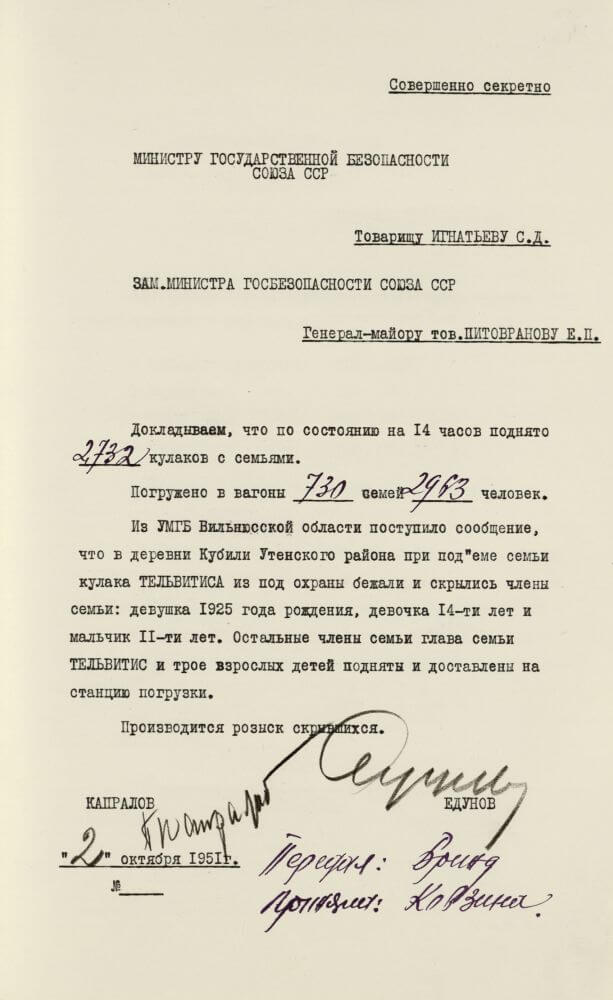
Report by Commissioner of USSR Ministry of State Security (MGB) in Lithuania, Lt. Gen. Y. Yedunov addressed to the leadership of the USSR MGB. It informs that on 2 October 1951 at 2 p.m., 2,732 families were gathered for deportation. 730 families and 2,963 persons were herded into wagons. It reports on an incident in Kubilių village in Utena district of Vilnius County, during which a family attempted escape from deportation.
From the Lithuanian Special Archive
From the Lithuanian Special Archive
From the Lithuanian Special Archive
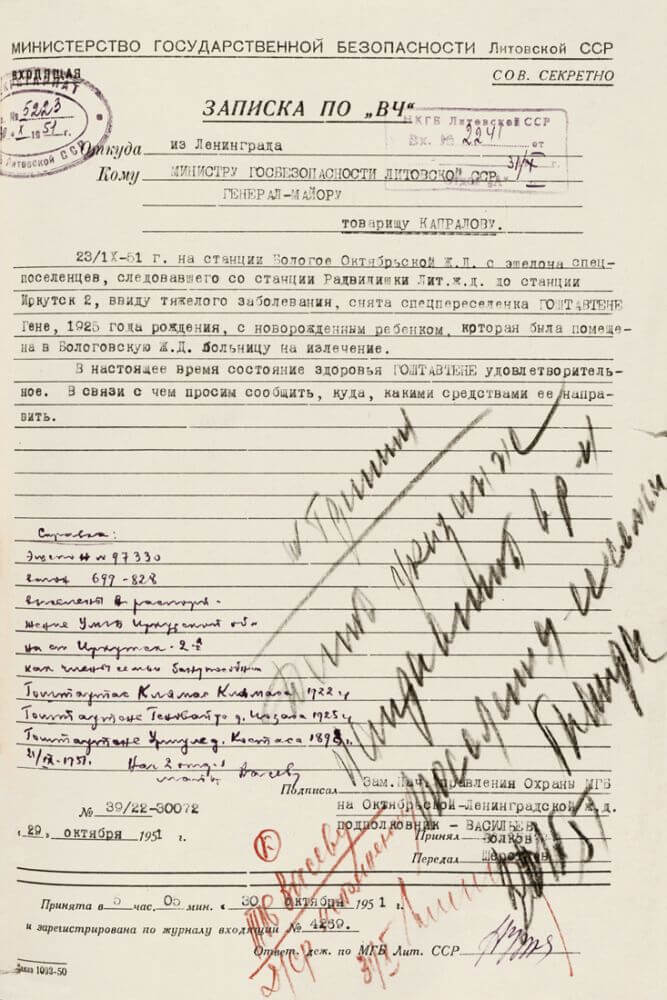
Report by Vasiliev, Colonel, Deputy Head of the MGB Protection Board of the railway section Oktyabrsky-Leningrad, to the Minister of State Security of the LSSR, Maj. Gen. P. Kapralov. The report informs that on 23 October 1951, a seriously ill deportee, Genė Goštautienė, with her newborn child, were disembarked from the Radviliškis to Irkutsk echelon of deportees. The woman was admitted to hospital.
From the Lithuanian Special Archive
